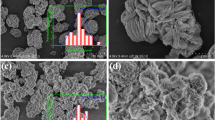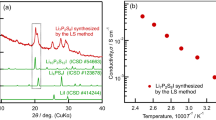Abstract
Nanometric amorphous iron-based oxides of bacterial origin show a great potential as an Fe3+/Fe0 conversion anode material for lithium-ion batteries. By means of in situ Mössbauer spectroscopy, chemical states of Fe ions were examined under the discharge-charge process of the bacterial iron-oxide electrode in a lithium-ion half-cell. As for the first discharge process, the successive reduction of Fe3+ → Fe2+ → Fe0 occurred in the electrode as a function of the cell voltage. While on the charge process, Fe0 in the electrode was oxidized directly to Fe3+ without going through Fe2+.
Similar content being viewed by others
References
Hashimoto, H., Kobayashi, G., Sakuma, R., Fujii, T., Hayashi, N., Suzuki, T., Kanno, R., Takano, M., Takada, J.: Bacterial nanometric amorphous Fe-based oxide: a potential lithium-ion battery anode material. ACS Appl. Mater. Inter. 6, 5374–5378 (2014)
Sakuma, R., Hashimoto, H., Kobayashi, G., Fujii, T., Nakanishi, M., Kanno, R., Takano, M., Takada, J.: High-rate performance of a bacterial iron-oxide electrode material for lithium-ion battery. Mater. Lett. 139, 414–417 (2015)
Hashimoto, H., Nishiyama, Y., Ukita, M., Sakuma, R., Nakanishi, M., Fujii, T., Takada, J.: Lithium storage properties of a bioinspired 2-line ferrihydrite: a silicon-doped, nanometric, and amorphous iron oxyhydroxide. Inorg. Chem. 54, 7593–7599 (2015)
Xu, S., Hessel, C.M., Ren, H., Yu, R., Jin, Q., Yang, M., Zhao, H., Wang, D.: α-Fe2O3 multi-shelled hollow microspheres for lithium ion battery anodes with superior capacity and charge retention. Energy Environ. Sci. 7, 632–637 (2014)
Ji, L., Toprakci, O., Alcoutlabi, M., Yao, Y., Li, Y., Zhang, S., Guo, B., Lin, Z., Zhang, X.: α-Fe2O3 nanoparticle-loaded carbon nanofibers as stable and high- capacity anodes for rechargeable lithium-ion batteries. ACS Appl. Mater. Interfaces. 4, 2672–2679 (2012)
Su, Q., Xie, D., Zhang, J., Du, G., Xu, B.: In situ transmission electron microscopy observation of the conversion mechanism of Fe2O3/graphene anode during lithiation-delithiation processes. ACS Nano. 7, 9115–9121 (2013)
Acknowledgements
The authors would like to thank Dr. M. Nakanishi for Raman measurements.
Author information
Authors and Affiliations
Corresponding author
Additional information
Publisher’s note
Springer Nature remains neutral with regard to jurisdictional claims in published maps and institutional affiliations.
This article is part of the Topical Collection on Proceedings of the 5th Mediterranean Conference on the Applications of the Mössbauer Effect (MECAME 2019) and 41st Workshop of the French-speaking Group of Mössbauer Spectroscopy (GFSM 2019), Montpellier, France, 19-23 May 2019
Edited by Pierre-Emmanuel Lippens, Yann Garcia, Moulay-Tahar Sougrati and Mira Ristic (†)
Electronic supplementary material
ESM 1
(DOCX 2034 kb)
Rights and permissions
About this article
Cite this article
Sakuma, R., Hashimoto, H., Fujii, T. et al. In situ Mössbauer analysis of bacterial iron-oxide nano-particles for lithium-ion battery. Hyperfine Interact 240, 80 (2019). https://doi.org/10.1007/s10751-019-1639-y
Published:
DOI: https://doi.org/10.1007/s10751-019-1639-y




